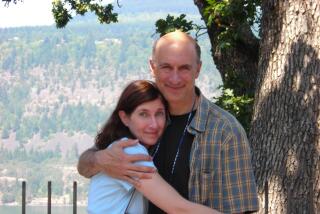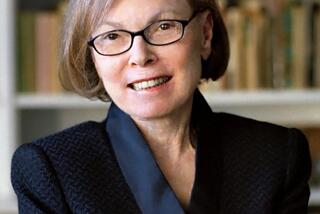The Ache of the Human Condition
- Share via
A phantom limb is flesh become memory, which in turn becomes the illusion of flesh. A person who has had an arm or leg cut off may feel it ache or itch as if it were still there. The severed nerves keep relaying reports to the brain from lost outposts, the way light from dead stars still reaches our eyes.
Janet Sternburg’s mother, Helen, battling circulation problems before her death, had first one leg, then the other, amputated. Sternburg’s father, Samuel, had died earlier after a series of strokes. “Phantom Limb,” the memoir, begins as the author’s attempt to research the phenomenon of phantom limb, which caused her mother considerable pain. It ends with Sternburg using the phenomenon as a metaphor for the loss of our loved ones, who remain intimately with us even after they’re gone.
“[T]he pain of the human condition is death, the one condition we never get over,” says Sternburg, a poet, essayist and photographer who teaches at the California Institute for the Arts (where her husband, Steven D. Lavine, is president). “And it means we all lose parts of ourselves along the way. No one survives intact. No one is exempt. In that democracy of sorrow lies our consolation.”
As in poetry, the language in this short book is compressed and suggestive; like an exhibit of still photography, it consists of sharp, cropped, seemingly disconnected images. Its portraits of Sternburg’s parents, lower-middle-class Boston Jews--the father a grocer and cab driver prone to explosions of temper; the mother cultivating a love of beauty beyond her means--at first strike us as frustratingly incomplete.
Then we get a feel for Sternburg’s method. The odd, out-of-context detail dropped into one chapter is explained in the next. A long-dead relative--”the oldest person ever to receive a graduate degree from Harvard”--is contrasted, apparently as a joke, with “the lobotomized end of the family spectrum.” It turns out, however, that two of the mother’s siblings--a schizophrenic brother and a suicidal sister--really were given frontal lobotomies and lived on for years with “the family that did this to them.” They looked “like zombies,” phantoms of themselves.
Finally, though, the portraits are incomplete because of the inevitable gaps in Sternburg’s memory. She consults a professor of neurology at UCLA. “When I’m trying to recall my parents’ living room,” she tells him, “I feel as though I’m searching for an image that already exists in me.”
“It may feel that way,” he answers, “but there’s no place in your brain where the living room exists, no permanently held picture of a sofa. Very little is stored in the brain.... Instead, think of your memories as connections constantly being made and unmade among synapses. The living room is delivered to you only during the window of time when you’re reconstructing it.” It’s as if the hulk of the Titanic on the sea floor didn’t exist except during the moments when submersibles flashed their lights on its rusting plates, just as a phantom limb exists only in the nerves’ messages. To some extent, we create the dead who live on in us, and the very scarcity and unreliability of our memories makes them precious.
Sternburg discovers that her search for consolation involves an acceptance of the pain of loss--the gaps along with the memories. After her mother’s first amputation, the lost leg hurt--yet the experience of phantom limb, Sternburg learned, is “essential for walking. When a prosthesis is strapped on, the phantom shoots out and ‘fills’ it. The brain then begins to accept the artificial leg as though it were part of the body.”
She considers the case of Madame I., a Frenchwoman a century ago who suffered from “general insensibility,” an inability to feel any part of her body, even to hear her own voice. Sternburg imagines a scene in which Madame I. has recovered enough to feel the pain of a fall and gladly accepts this as the price for experiencing “the taste of food ... the scent of flowers” and hearing the voices of her children at last.
More to Read
Sign up for our Book Club newsletter
Get the latest news, events and more from the Los Angeles Times Book Club, and help us get L.A. reading and talking.
You may occasionally receive promotional content from the Los Angeles Times.









